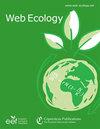马达加斯加东北部波尔图圣港马氏Pipistrellus maderensis的生境关联、系统发育和饮食研究
IF 2.4
3区 环境科学与生态学
Q2 ECOLOGY
引用次数: 0
摘要
摘要大约60%的蝙蝠物种生活在岛屿上,近四分之一的蝙蝠是岛屿特有物种。蝙蝠通常是海洋岛屿上唯一的本土陆生哺乳动物,尽管人为压力越来越大,但人们对大多数岛屿蝙蝠种群的分布、自然历史和种群状况知之甚少。亚热带的马德拉群岛由马德拉火山岛、圣港岛和沙漠岛组成,是马卡罗尼亚特有的马德拉Pipistrellus maderensis、特有亚种Nyctalus leisleri verrucosus和Plecotus austracus的家园。马德拉岛和圣港都有马氏Pipistrellus maderensis,而另外两个物种只在马德拉岛有记录。然而,波多黎各已经有超过15年没有蝙蝠的记录了,这引发了人们对岛上蝙蝠可能已经灭绝的担忧。2021年7月,我们使用audiomoth被动声学记录仪进行了全岛范围的声学调查,在46个采样点中的28个(60%)检测到马氏pipistrellus maderensis。该物种的活动与人工水源密切相关,来自6个捕获个体的遗传样本显示,在圣港和马德拉岛的Pipistrellus maderensis种群具有密切的系统发育亲缘关系。此外,我们发现该物种以多种昆虫为食,包括几种经济上重要的害虫和疾病媒介。这些发现强调有必要针对现存岛屿蝙蝠种群及其提供的潜在生态系统服务开展更多的保护和研究工作。本文章由计算机程序翻译,如有差异,请以英文原文为准。
Insights into the habitat associations, phylogeny, and diet of Pipistrellus maderensis in Porto Santo, northeastern Macaronesia
Abstract. Around 60 % of all bat species occur in islands, and nearly one in four is
an insular endemic. Bats are often the only native terrestrial mammals in
oceanic islands, and despite increasing anthropogenic pressures, little is
known about the distribution, natural history, and population status of most
insular bat populations. The sub-tropical archipelago of Madeira is composed
of the volcanic islands of Madeira, Porto Santo, and Desertas and is
home to the Macaronesian endemic Pipistrellus maderensis, to the endemic subspecies Nyctalus leisleri verrucosus, and to Plecotus austriacus. Pipistrellus maderensis is known
to both Madeira and Porto Santo, whereas the other two species have only
been recorded in the former. However, no bats have been recorded in Porto Santo
for over 15 years, raising fears that bats are probably extinct in the
island. In July 2021, we conducted an island-wide acoustic survey using
AudioMoth passive acoustic recorders, leading to the detection of
Pipistrellus maderensis in 28 out of the 46 sampling sites (60 %). The species' activity was
strongly associated with artificial water sources, and genetic samples from
six captured individuals revealed that the populations of Pipistrellus maderensis in Porto Santo and
Madeira have a close phylogenetic affinity. Furthermore, using DNA
metabarcoding, we found that the species feeds on a wide variety of insects,
including several economically important pest species and disease vectors.
These findings emphasise the need to target more conservation and research
efforts towards extant island bat populations and the potential ecosystem
services they provide.
求助全文
通过发布文献求助,成功后即可免费获取论文全文。
去求助
来源期刊

Web Ecology
Agricultural and Biological Sciences-Ecology, Evolution, Behavior and Systematics
CiteScore
4.60
自引率
0.00%
发文量
6
审稿时长
17 weeks
期刊介绍:
Web Ecology (WE) is an open-access journal issued by the European Ecological Federation (EEF) representing the ecological societies within Europe and associated members. Its special value is to serve as a publication forum for national ecological societies that do not maintain their own society journal. Web Ecology publishes papers from all fields of ecology without any geographic restriction. It is a forum to communicate results of experimental, theoretical, and descriptive studies of general interest to an international audience. Original contributions, short communications, and reviews on ecological research on all kinds of organisms and ecosystems are welcome as well as papers that express emerging ideas and concepts with a sound scientific background.
 求助内容:
求助内容: 应助结果提醒方式:
应助结果提醒方式:


